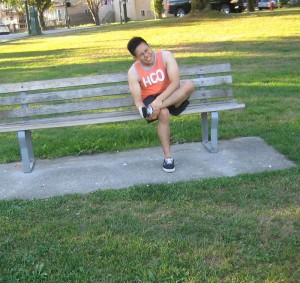The Achilles tendon is the biggest tendon in the body. It is positioned in the rear part of the heel and links the heel bone to the calf muscles. Oftentimes, overuse from running causes the tendon to become inflamed which results to Achilles tendinitis.
It is important to note that Achilles tendinitis can develop due to various reasons including increased mileage or speed while running, overuse, running hills, climbing stairs, sprinting, starting off rapidly after a period of rest, heel spurs, taut calf muscles, poor stretching, tendon injuries, lack of warm-up before exercise, flat arches and using footwear with poor support.

What are the types?
There are 2 forms of Achilles tendinitis – non-insertional and insertional.
- The non-insertional form develops once the middle region of the tendon is torn and becomes inflamed. It generally occurs among active, young individuals.
- The insertional form involves the lower region of the tendon that is linked to the heel. This form can affect anyone even those who are not physically active.
What are the signs?
The general signs of Achilles tendinitis include:
- Heel pain which is aggravated with activity, occurs in the morning and after a running routine
- Stiffness or rigidity of the Achilles tendon
- Puffiness in the rear part of the heel
- Reduced range of motion in the foot
In case there is a popping sensation in the rear part of the heel, it indicates that the tendon has ruptured.
Management of Achilles tendinitis
Achilles tendinitis generally heals on its own with conservative measures at home but it might take some time for the discomfort to settle. The treatment must be started as soon as possible.
It might take 3 months or longer for the discomfort to settle even if treatment is started right away. The recovery period might take 6 months or longer if treatment was delayed for several months.
The initial measure is to allow the injured foot to rest. The individual should avoid engaging in activities that can worsen the pain especially high-impact activities such as running. It is also recommended to perform low-impact activities such as biking, walking, swimming and elliptical machines.
Apply an ice pack on the tendon for 20 minutes several times throughout the day. This helps in reducing the discomfort and swelling. In addition, non-steroidal anti-inflammatory drugs (NSAIDs) help reduce the pain and swelling.
Disclaimer / More Information
The information posted on this page on Achilles tendinitis is for learning and educational purposes only. To learn to recognize the signs of this tendon condition, register for first aid training at one of our training centers located throughout Canada. The training centers are in Edmonton, Calgary, Vancouver, Kelowna, Saskatoon, Victoria, Surrey, Mississauga, Winnipeg, Red Deer, Toronto, Ottawa and Halifax.
